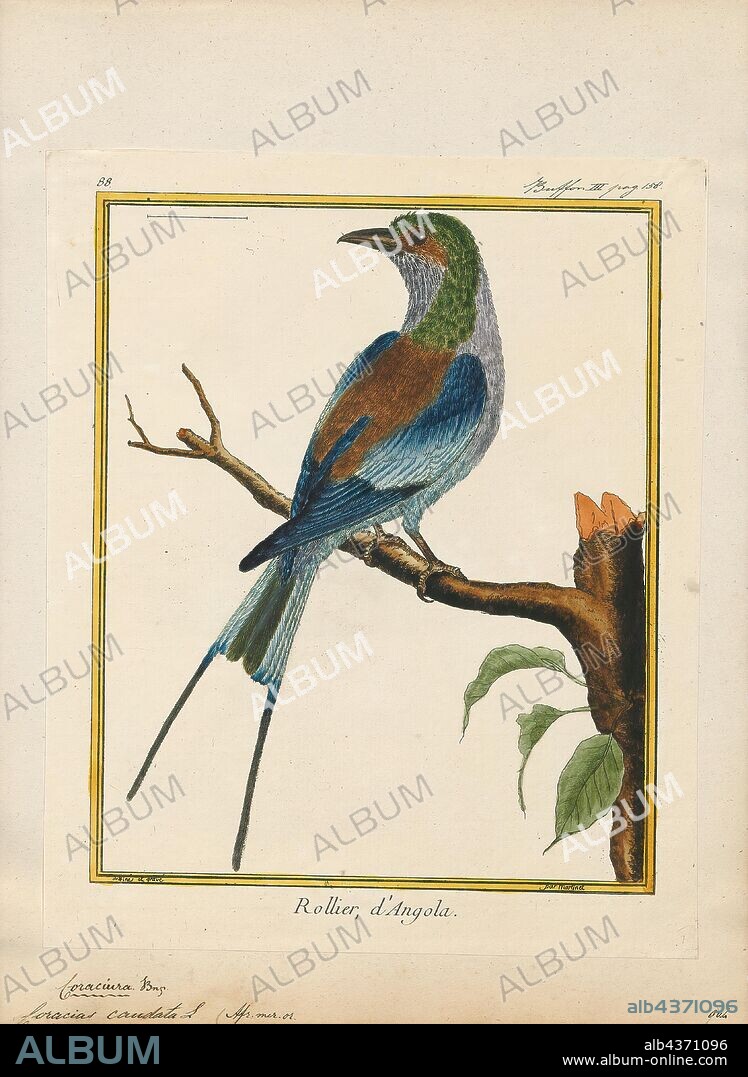alb4371096
Coracias caudata, Print, The lilac-breasted roller (Coracias caudatus) is an African member of the roller (or Coraciidae) family of birds. It is widely distributed in sub-Saharan Africa, and is a vagrant to the southern Arabian Peninsula. It prefers open woodland and savanna, and it is for the most part absent from treeless places. Usually found alone or in pairs, it perches conspicuously at the tops of trees, poles or other high vantage points from where it can spot insects, lizards, scorpions, snails, small birds and rodents moving about on the ground. Nesting takes place in a natural hole in a tree where a clutch of 2–4 eggs is laid, and incubated by both parents, who are extremely aggressive in defence of their nest, taking on raptors and other birds. During the breeding season the male will rise to a fair height (69 to 144 metres), descending in swoops and dives, while uttering harsh, discordant cries. The sexes are different in coloration, and juveniles lack the long tail streamers of adults. This species is unofficially considered the national bird of Kenya. Alternate names for the lilac-breasted roller include the fork-tailed roller, lilac-throated roller (also used for a subspecies of purple roller) and Mosilikatze's roller., 1700-1880.

|
Zu einem anderen Lightbox hinzufügen |
|
Zu einem anderen Lightbox hinzufügen |



Haben Sie bereits ein Konto? Anmelden
Sie haben kein Konto? Registrieren
Dieses Bild kaufen.
Nutzung auswählen:

Untertitel:
Siehe automatische Übersetzung
Coracias caudata, Print, The lilac-breasted roller (Coracias caudatus) is an African member of the roller (or Coraciidae) family of birds. It is widely distributed in sub-Saharan Africa, and is a vagrant to the southern Arabian Peninsula. It prefers open woodland and savanna, and it is for the most part absent from treeless places. Usually found alone or in pairs, it perches conspicuously at the tops of trees, poles or other high vantage points from where it can spot insects, lizards, scorpions, snails, small birds and rodents moving about on the ground. Nesting takes place in a natural hole in a tree where a clutch of 2–4 eggs is laid, and incubated by both parents, who are extremely aggressive in defence of their nest, taking on raptors and other birds. During the breeding season the male will rise to a fair height (69 to 144 metres), descending in swoops and dives, while uttering harsh, discordant cries. The sexes are different in coloration, and juveniles lack the long tail streamers of adults. This species is unofficially considered the national bird of Kenya. Alternate names for the lilac-breasted roller include the fork-tailed roller, lilac-throated roller (also used for a subspecies of purple roller) and Mosilikatze's roller., 1700-1880
Bildnachweis:
Album / quintlox
Freigaben (Releases):
Bildgröße:
3376 x 4624 px | 44.7 MB
Druckgröße:
28.6 x 39.1 cm | 11.3 x 15.4 in (300 dpi)
Schlüsselwörter:
ABDRUCK • ABWEHR (VERTEIDIGUNG) • BAUM • ELTERN • FAMILIE • KENIA • LOCKENWICKLER • NEST • SAVANNE • VERTEIDIGUNG (ABWEHR) • VERTEIDIGUNG • VOGELNEST • WALZE


 Pinterest
Pinterest Twitter
Twitter Facebook
Facebook Link kopieren
Link kopieren Email
Email
